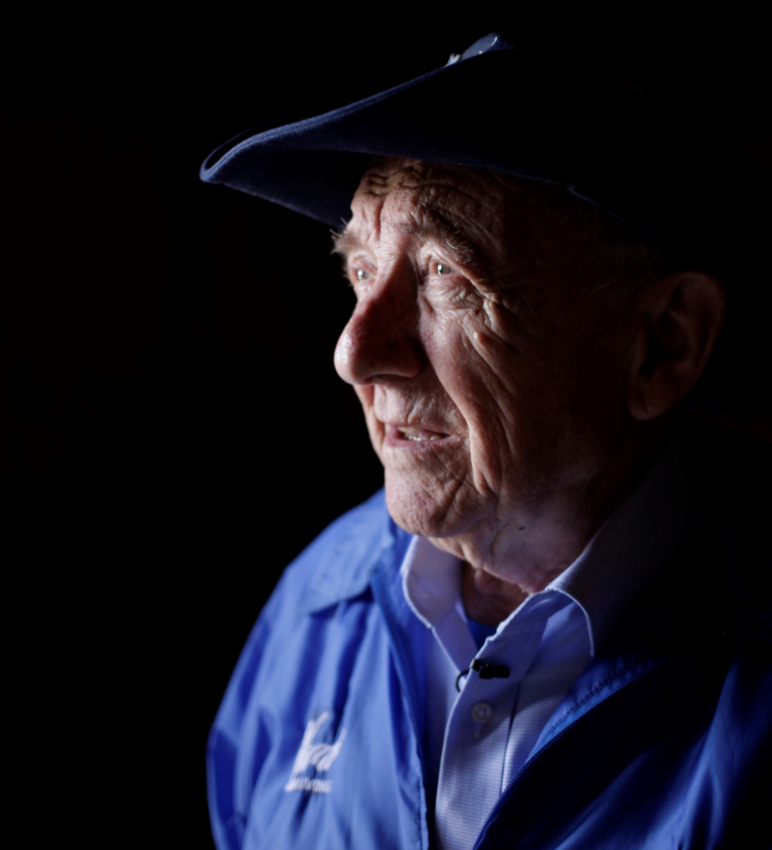We Remember Max Glauben

USC Shoah Foundation is saddened to learn about the passing of Max Glauben, a child survivor of the Warsaw Ghetto, the Majdanek and Dachau concentration camps, and a veteran of the United States Army. In 2018, Max was interviewed by USC Shoah Foundation, in association with the Dallas Holocaust and Human Rights Museum—a center he helped found—for the interactive Dimensions in Testimony exhibit. He recorded his original video testimony for USC Shoah Foundation in Dallas, Texas in 1996.
Max was born Moniek Glauben in Warsaw, Poland on October 14, 1930. His father Issac owned a local Yiddish newspaper, the Tageblatt, and his mother Feige was an active member in Warsaw’s Jewish community. Max and his younger brother Hieniek attended a private Jewish school until their education was cut short by the German invasion of Poland in September 1939.
As the Nazis imposed anti-Jewish measures in all areas they occupied, Isaac’s newspaper, along with all other Jewish businesses and institutions, was shut down. In November 1940 the Warsaw Ghetto was established around the neighborhood in which Max and his family lived. Every Jew in the capital was rounded up and forced into the small confines of the Ghetto. The Glauben family offered their home to those who had none. In his testimony, Max described dead bodies on the street.
“The ghetto was about one square mile. And, by the time they put in excess of a half a million people in there, any imaginable disease was in epidemic stages in that area,” he said.
By the age of 10, Max had become involved in a covert smuggling operation in which he stowed away in wagons to move food and other supplies in and out of the Ghetto.
In 1943, the Glaubens found themselves in the middle of the Warsaw Ghetto Uprising. The family went into hiding for several weeks but were eventually found by the Nazis. Among the last Jews to be liquidated from the Ghetto, the family was sent in boxcars to Majdanek concentration camp, where Max’s mother and younger brother were sent to the gas chambers immediately upon arrival.
Max, not quite 13, and his father were selected for slave labor and sent to work under a Nazi named Keller in an airplane factory in Budzyn, a satellite camp of Majdanek. Max’s father was killed soon after.
Max remained in Budzyn working under Keller until the end of 1943, after which he spent the remainder of the war moving between various factories in Mielec, Wieliczka, Plaszów, and Flossenburg.
In spring of 1945, as the Allied forces advanced, Max and his fellow Jewish slave laborers were loaded into boxcars and sent to an unknown destination. The trains were bombarded by artillery fire from American and British planes, and the passengers forced to disembark on a death march towards Dachau. In the town of Schawarzenfeld, Max was liberated by American troops. He was 14 years old.
After the war, Max relied on services provided by Allied forces to survive. He moved from town to town in Germany, working various odd jobs. In 1947, American soldiers recommended that he and his friends try to immigrate to the U.S and by the end of the year he was able to secure passage.
“I was placed on a ship in Bremerhaven, Germany. And we stopped in Bremerhaven Thanksgiving Day of 1947. We were placed on a ship which was called the United States SS Marine Flasher… On December the 13, I arrived in the United States. And I was placed in the Bronx, on Cauldwell Avenue, with the Jewish Children's Service.”
Through the children’s service, Max ended up in Atlanta, Georgia where he found a job at Sears and attended night school. In 1951, he was drafted into the U.S Army and sent to Fort Hood, Texas, where he rose to the rank of Staff Sergeant.
After an honorable discharge in 1953, Max chose to stay in Texas, and moved to Dallas. He married his wife Freida that same year. The Glaubens had three children—Shari, Phillip, and Barry—and Max began working with Frieda’s brother at the Imperial Garment Supply company.
In 1984, Max was among the Holocaust survivors who founded Dallas’ first Holocaust Center. Since that time, he has often shared his history with groups of students and adults. For many years, he also participated in the annual March of the Living in Poland with a group of Jewish teenagers from Dallas.
After recording his Dimensions in Testimony interview with USC Shoah Foundation, Max noted the significance of the new technology: “My reward will be that after the survivors are all gone, there is going to be a place where my child, my grandchild, my great-grandchild can go and still be able to ask a question, be curious about the worst tragedy ever in the darkest period of human history, and know we survived, using the defense mechanisms we all possess.”
Watch his full testimony in the Visual History Archive online
Holocaust survivors tell their stories on location at concentration camps for 360-degree videos
Dimensions in Testimony theater established at new Dallas Holocaust and Human Rights Museum
Like this article? Get our e-newsletter.
Be the first to learn about new articles and personal stories like the one you've just read.